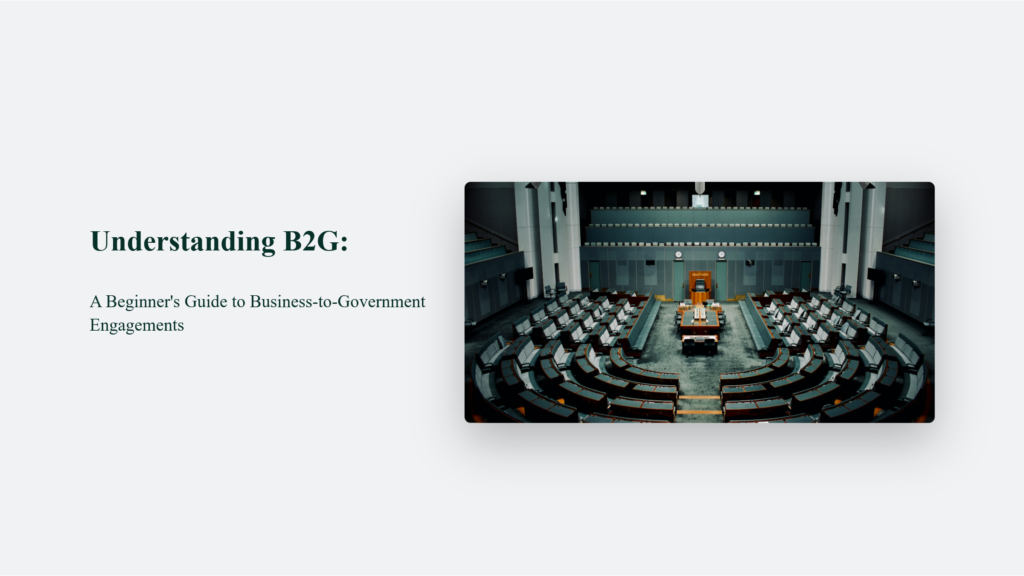

Understanding B2G: A Beginner’s Guide to Business-to-Government Engagements

As Seen On
In the business world, there are many acronyms, but one that might need to be more familiar is B2G, which stands for Business-to-Government. It’s a unique sector where companies directly offer their products, services, or information to government entities. It could be anything from providing IT solutions to constructing highways or supplying office equipment to city hall.

The Unique World of B2G
Picture this: a small startup developed an innovative technology to improve water purification processes. After several successful pilots, they catch the eye of the local government and are invited to bid for a project. This scenario exemplifies the essence of B2G – where the government is the client, and businesses of all sizes strive to meet their needs.
How Does B2G Work?
The Business-to-Government (B2G) process is a critical pathway through which the public interacts with the private sector, primarily aiming to procure goods, services, or expertise to fulfil governmental needs. This intricate dance begins with the government agency identifying a requirement that cannot be met internally, thus necessitating an external procurement.
Here’s a detailed look into how this process unfolds, influenced by principles of transparency, competitiveness, and the pursuit of value for public funds.
Step 1: Identifying the Need
The journey starts with a governmental department or agency recognizing a need, whether it’s for technological upgrades, infrastructure projects, consultancy services, or supplies. This need is meticulously documented, outlining the project’s scope, specifications, and intended outcomes. The depth and detail in this documentation are crucial as they guide the subsequent steps in the procurement process.
Step 2: Issuing a Request for Proposals (RFP)
Once the need is clearly defined, the government agency issues an RFP, a formal document inviting companies to submit their proposals to meet the specified requirements. RFPs are designed to be comprehensive, including what is needed and criteria for evaluating proposals, submission deadlines, and contractual terms.
Step 3: Response from Vendors
Businesses interested in providing the requested goods or services prepare and submit their proposals in response to the RFP. These proposals are not just about pricing; they also detail the approach, timelines, compliance with specifications, and any value-added benefits. The preparation of these documents is often meticulous, requiring significant effort to align with the government’s criteria.
Step 4: Evaluation of Proposals
The received proposals are then evaluated against the pre-defined criteria mentioned in the RFP. This stage is critical for ensuring transparency and fairness, as it involves a thorough assessment of each proposal’s merits, adherence to requirements, and the overall value it offers in terms of cost, efficiency, and innovation.
Step 5: Awarding the Contract
Following the evaluation, the government agency awards the contract to the company whose proposal best meets the project’s objectives and offers the best value for money. It’s important to note that the lowest bid does not always win; the decision is based on a combination of factors, including quality, sustainability, and cost-effectiveness.
Step 6: Execution and Delivery
With the contract awarded, the selected company proceeds to execute the project according to the agreed terms. This phase includes regular monitoring and evaluation by the government agency to ensure compliance with the contract and achieve the desired outcomes.

Challenges and Considerations
While designed to be equitable and efficient, the B2G procurement process is not without its challenges. Companies new to the B2G marketplace often face a steep learning curve, dealing with complex bidding processes, stringent compliance requirements, and the need for meticulous documentation. Moreover, the public sector’s procurement cycles can be lengthy, requiring patience and long-term planning from vendors.
Despite these challenges, the B2G sector presents significant opportunities for businesses of all sizes. From small enterprises offering niche services to large corporations with comprehensive solutions, the public sector needs various vendors to meet its diverse requirements. Success in this market includes winning contracts and building a reputation for reliability and quality, opening doors to future opportunities.
A Glimpse into the B2G Market
The B2G market is colossal, with the federal government alone spending billions daily on external contractors. Even small businesses can secure significant contracts, contributing to the government’s goal of involving small enterprises in public projects. Imagine a local tech firm being awarded a contract to upgrade the IT infrastructure of a state agency—that’s B2G in action.
The Bottom Line:
In this detailed exploration of B2G, we’ve uncovered the basics, opportunities, and unique aspects that make Business-to-Government engagements a compelling area for businesses aiming to contribute to the public sector. Whether you’re a tech startup or a construction giant, the B2G domain opens a realm of possibilities for making a significant impact.
Frequently Asked Questions:
How do companies win B2G contracts?
Companies win contracts by responding to RFPs issued by government agencies and successfully bidding against competitors.
How do companies win B2G contracts?
Companies win contracts by responding to RFPs issued by government agencies and successfully bidding against competitors.
Are there opportunities for small businesses in B2G?
Yes, the government often sets goals to ensure a portion of contracts are awarded to small businesses.
Konger
Up until working with Casey, we had only had poor to mediocre experiences outsourcing work to agencies. Casey & the team at CJ&CO are the exception to the rule.
Communication was beyond great, his understanding of our vision was phenomenal, and instead of needing babysitting like the other agencies we worked with, he was not only completely dependable but also gave us sound suggestions on how to get better results, at the risk of us not needing him for the initial job we requested (absolute gem).
This has truly been the first time we worked with someone outside of our business that quickly grasped our vision, and that I could completely forget about and would still deliver above expectations.
I honestly can't wait to work in many more projects together!
Disclaimer
*The information this blog provides is for general informational purposes only and is not intended as financial or professional advice. The information may not reflect current developments and may be changed or updated without notice. Any opinions expressed on this blog are the author’s own and do not necessarily reflect the views of the author’s employer or any other organization. You should not act or rely on any information contained in this blog without first seeking the advice of a professional. No representation or warranty, express or implied, is made as to the accuracy or completeness of the information contained in this blog. The author and affiliated parties assume no liability for any errors or omissions.

